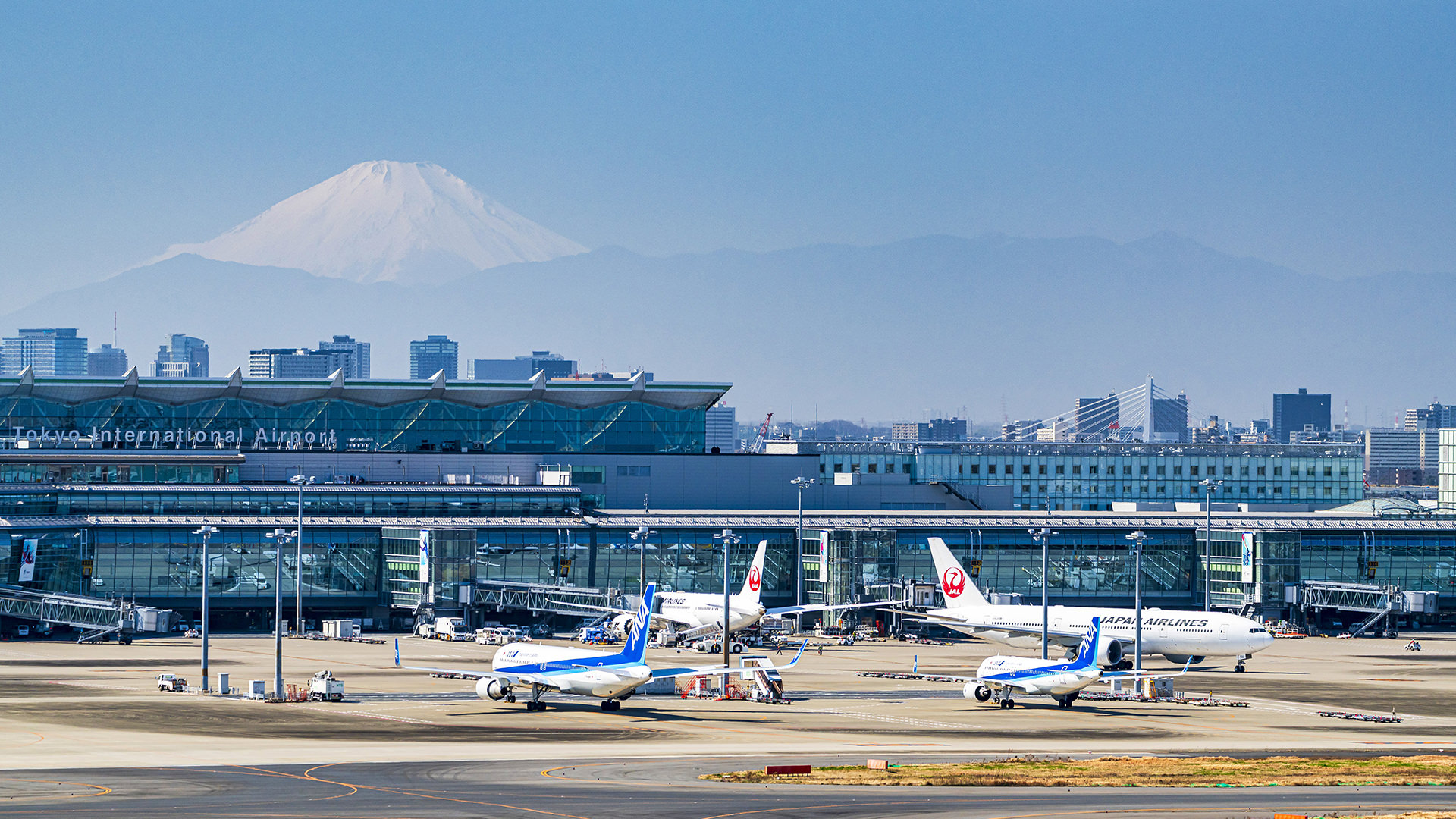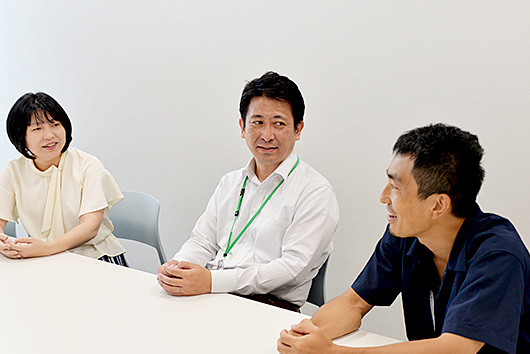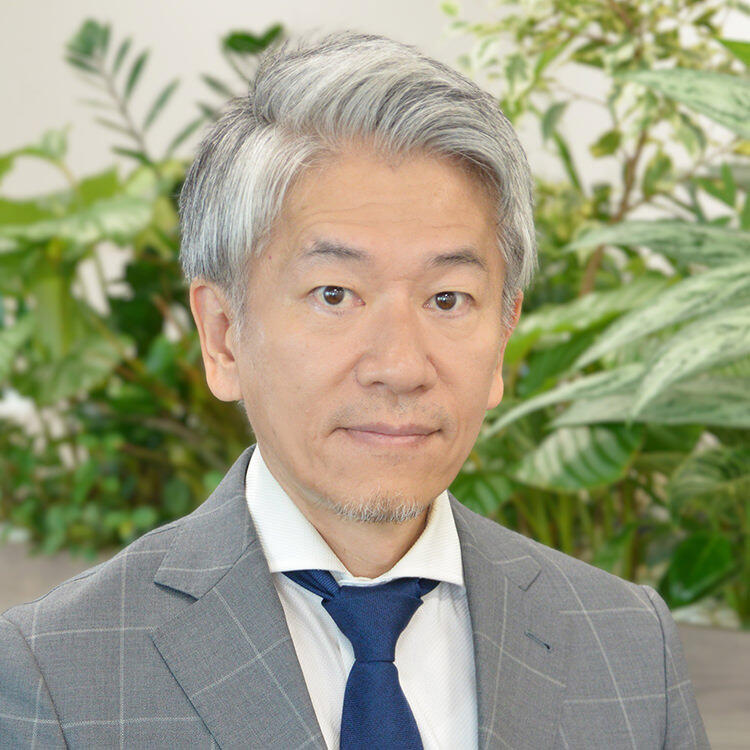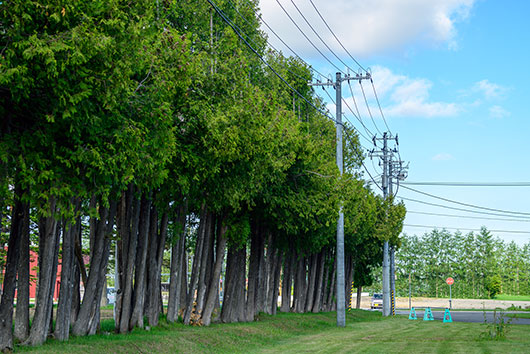Efforts are underway in various fields to achieve carbon neutrality and a carbon-free society by 2050. Decarbonization of the airport sector is one of these efforts, and decarbonization is an urgent priority for airports, which serve as gateways to overseas destinations, in order to maintain their international competitiveness. However, there are many businesses involved in airports, and the entities implementing initiatives are diverse, making it difficult to concretize and execute plans.
We spoke to three people who were involved in creating the Ministry of Land, Infrastructure, Transport and Tourism 's guidelines for developing airport decarbonization promotion plans - Motohiro KIWATARI, head of the Aviation Planning General Manager in the Aviation Dept., Takahiro IMAMURA, who is in the same department, and Daiki YAMASHITA, General Manager in Green Social Strategy Dept.- about what the key points are in achieving airport decarbonization.
INDEX
- How Are Airport Decarbonization Efforts Progressing?
- What Exactly Does Airport Decarbonization Entail?
- Current Status of Decarbonization of Japan's Airports
- Challenges in Decarbonizing Airports
- The Key is to Consider Carbon Management for the Entire Airport
- Regional Collaboration and Contribution through Making the Airport a Renewable Energy Hub
- Strategies Need to be Developed to Help Airports Achieve Decarbonization in the Region
- What PACIFIC CONSULTANTS can do
How Are Airport Decarbonization Efforts Progressing?
The Japanese government, which has declared its intention to achieve carbon neutrality by 2050, formulated the Sixth Basic Energy Plan in 2021 as a roadmap for achieving this. Decarbonization in the aviation sector targets two areas: reducing CO2 emissions from aircraft operations and from airport facilities and airport vehicles. The basic plan sets out four points: (1) introducing new technologies to equipment and supplies, (2) improving flight operations by enhancing air traffic control, (3) promoting the introduction of SAF (Sustainable Aviation Fuel), and (4) promoting efforts to reduce CO2 emissions from airport facilities and airport vehicles, while also turning airports into renewable energy hubs. The specific goals for airport decarbonization are to reduce Greenhouse Gas Emissions at each airport by more than 46% in 2030 compared to FY2013, and to aim for a high level of carbon neutrality for the entire airport. In addition, it is set out that by 2050, based on the premise of carbon neutrality, the use of new technologies will be promoted and credits will be created and expanded.
To achieve this decarbonization of airports, Ministry of Land, Infrastructure, Transport and Tourism published the "Guidelines for formulating plans to promote decarbonization of airports" in Mar. 2022 (currently revised to its second edition). Furthermore, in Dec. 2022, the Ministry will present the Basic Policy for Promoting Decarbonization of Aviation, based on partial amendments to the Aviation Act and other laws, and will call for airport managers at each airport to take the lead in formulating and implementing plans that set out specific goals and initiatives.
What Exactly Does Airport Decarbonization Entail?
There are two main things that need to be done to decarbonize airports. The first is the promotion of energy conservation, that is, the reduction of emissions of greenhouse gas (based on CO2 but also including nitrous oxide, chlorofluorocarbons, etc.) from airport facilities, airport vehicles, aircraft, and airport access, and the other is the promotion of renewable energy hubs, specifically the introduction of renewable energy such as solar power generation and hydrogen.
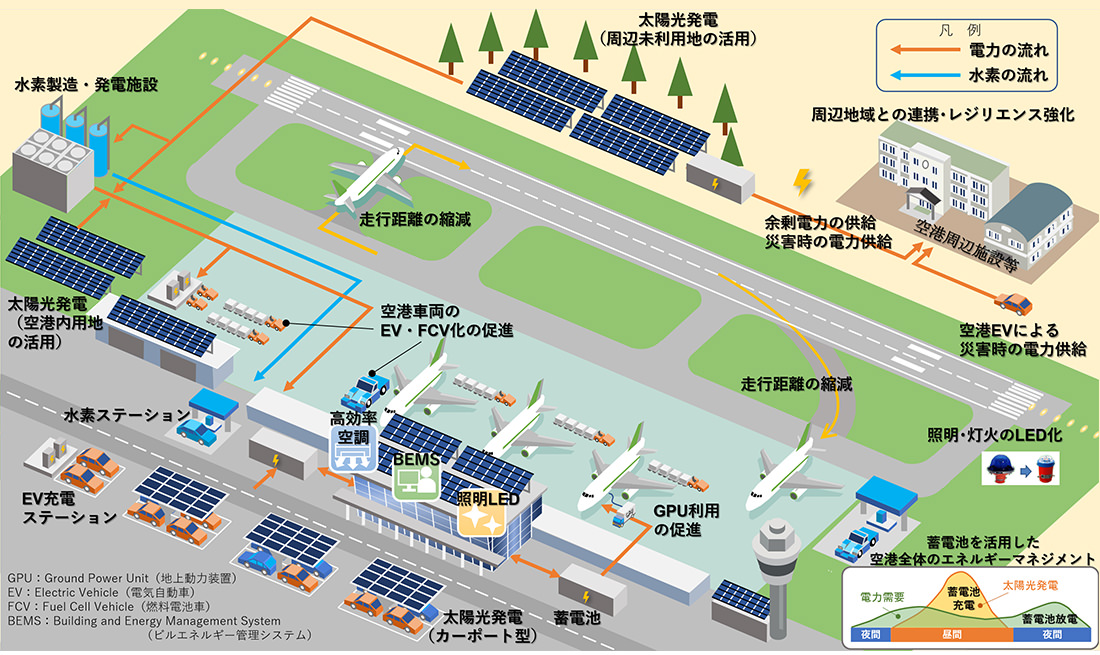
Source: "Planning Guidelines for Promoting Airport Decarbonization, Second Edition (Dec. 2022)" (Ministry of Land, Infrastructure, Transport and Tourism Civil Aviation Bureau)
| Item | Main initiatives |
|---|---|
| Airport facilities | Energy conservation in airport facilities (terminal buildings, control towers, government buildings, and other facilities owned by operators) / LED conversion of airport lighting |
| Airport Vehicles | Conversion of airport vehicles to EVs *1 and FCVs *2 / Development of charging facilities and hydrogen stations, etc. |
| Aircraft | Reduce driving distances by improving taxiways/Use of GPUs *3 for parked aircraft (for flights at altitudes of 3,000 feet or less) |
| Promoting the introduction of renewable energy, etc. | Solar power generation/storage batteries/hydrogen, etc. |
| Cross-sectional efforts | Energy management/Regional cooperation and strengthening resilience |
| Other Initiatives | Airport access, carbon sink measures, credit utilization, etc. |
Currently, the total amount of CO2 emissions at the airport, including airport facilities and airport vehicles, is about 850,000 tons, with emissions from building facilities accounting for nearly 90% at 740,000 tons. Looking at this breakdown, emissions from passenger terminal buildings account for nearly half at 45%, and emissions from energy supply facilities such as geo-cooling companies also account for a large amount at 27%.
| Facilities | Million tons of CO2 | |
|---|---|---|
| Airport facilities | Building Facilities | 74 |
| Airfield lighting | 2 | |
| Airport Vehicles | GSE etc. ※4 | 9 |
| subtotal | 85 | |
| Aircraft | Parked | 43 |
| While driving | 126 | |
| Airport Access | Private car, etc. | 133 |
| total | 387 | |
source: "Airport Decarbonization Initiative Policy (Feb. 2022)" (Ministry of Land, Infrastructure, Transport and Tourism Civil Aviation Bureau)
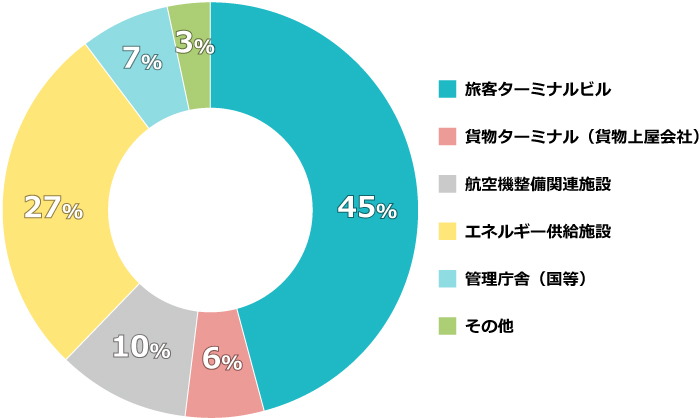
source:" Created from "Manual for Promoting Airport Decarbonization Projects (First Edition)" (Ministry of Land, Infrastructure, Transport and Tourism Civil Aviation Bureau, Dec. 2023)
Current Status of Decarbonization of Japan's Airports
Toward achieving the 2030 and 2050 targets for decarbonizing airports, airport managers are currently formulating promotion plans and organizing the Airport Decarbonization Promotion Council, which will serve as the parent organization for these efforts, to begin implementing the plans where possible. However, even looking at the state of the plan formulation, it must be said that Japan's efforts to decarbonize airports are still insufficient.
For example, there is the Airport Carbon Accreditation (ACA) established by Airports Council International (ACI) as an international benchmark for decarbonizing airports. It certifies airports in five levels, from Level 1 "CO2 emissions calculation" to Level 5 "Net zero achievement in SCOPE 1 and 2, and commitment to achieving net zero in SCOPE 3." In Japan, only five of the 97 airports in the country have obtained ACA certification.
| Country name | Number of airports with ACA certification *5 |
|---|---|
| America | 54 |
| Canada | 27 |
| France | 84 |
| Germany | 8 |
| England | 24 |
| Italy | 17 |
| Japan | 5 |
| Airport name | Airport Manager | Publication URL |
|---|---|---|
| Narita International Airport | NARITA INTERNATIONAL AIRPORT CORP. | https://www.naa.jp/eco/news/1201_23078.html |
| Chubu Centrair International Airport | CENTRAL JAPAN INTERNATIONAL AIRPORT CO., LTD. | https://www.centrair.jp/corporate/csr/environment/activity/decarbon.html |
| Kansai International Airport | NEW KANSAI INTERNATIONAL AIRPORT CO., LTD. | http://www.nkiac.co.jp/decarbonizing/index.html |
| Osaka International Airport | NEW KANSAI INTERNATIONAL AIRPORT CO., LTD. | http://www.nkiac.co.jp/decarbonizing/index.html |
| Prefectural Nagoya Airport | Aichi prefecture | https://www.pref.aichi.jp/soshiki/kouku/datsutanso-keikaku.html |
Source: "Status of airport decarbonization promotion plan formulation" (Ministry of Land, Infrastructure, Transport and Tourism)
| Planning body | Company | Country | Region | Total |
|---|---|---|---|---|
| Promotion plan formulation and approval | 4 | - | 1 | 5 |
| Promotion plan creation | - | 27 | - | 27 |
| Establishment of a council | - | - | 25 | 25 |
Source: "Efforts at each airport (status of formulation of airport decarbonization promotion plans)" (Ministry of Land, Infrastructure, Transport and Tourism)
In addition, 32 airports have formulated promotion plans based on the national Basic Policy for Promoting Decarbonization of Aviation, and 25 airports have established councils, while other airports are currently considering decarbonization efforts.
Challenges in Decarbonizing Airports
The obstacle to the promotion of these initiatives lies in Japan's unique airport management and operation system. At airports overseas, the entire airport is managed and operated by a single business entity, such as the national or local government, or a private company. In Japan, Narita International Airport, Kansai International Airport, Chubu Centrair International Airport, etc. are managed by a single company, but apart from these, runways, taxiways, and aprons are owned by the national or local government, terminal buildings are owned and operated by private companies, including the third sector, and ground operations necessary for aircraft operation are under the jurisdiction of airlines or ground handling companies. In particular, large airports such as Haneda Airport have building facilities of many businesses. In addition, the energy supply to the building facilities is also provided by a separate company. In other words, many business entities exist and operate within one airport.
Individual business entities are considering measures such as energy conservation, the introduction of renewable energy, and even carbon neutrality within the scope of their own business, but naturally they do not have a perspective on how to proceed with decarbonization of the entire airport. Even if the national and local governments, as administrators, set targets for the airport, they cannot fully enforce them and take the lead on individual business entities.
The Key is to Consider Carbon Management for the Entire Airport
Some may think that if each individual business entity achieves carbon neutrality, the entire airport will achieve carbon neutrality as a result. However, in the limited space of an airport, most of whose land is owned by national and local governments, there are limited measures that can be taken, making it difficult for any one entity to achieve carbon neutrality.
For example, terminal buildings use a lot of energy for air conditioning and lighting, so in order to achieve carbon neutrality, it is essential to introduce renewable energy sources such as solar power generation in addition to Energy-saving Measures. However, it is not possible to install enough power-generating panels to cover the energy needs of the entire building on the roof of the terminal building, which is owned by the company. On the other hand, it is also not possible to install panels on the roof of another company's building or on airport grounds, which belong to the government.
Furthermore, even if an airline or its group companies wanted to convert all GSE vehicles to EVs, the vehicles would not be able to operate if charging facilities were not available within the airport. If it is not known what type of charging facilities will be installed, where in the airport, and how many, it is not possible to make plans to introduce or operate EVs. On the other hand, unless the airport company knows how much demand there is for charging facilities, it cannot predict the profitability of the business and cannot begin construction. Without a perspective that goes beyond the boundaries of individual companies and considers carbon management for the entire airport, it will be impossible to move forward with decarbonizing the airport.
Regional Collaboration and Contribution through Making the Airport a Renewable Energy Hub
Furthermore, when considering decarbonization of airports, it is essential to consider the perspective of the region in which the airport is located. As a base for the aviation network, airports are important public infrastructure that support the local economy and society. They play a role in maintaining the vitality of the region, and the introduction of renewable energy to decarbonize airports must also be considered as a way to decarbonize the region and strengthen its resilience.
For example, regarding renewable energy generation, the airport has a large area that can be used for introducing solar power generation, which generates surplus electricity that cannot be consumed within the airport. This can be supplied to surrounding public facilities, homes, airport-related facilities, etc., making a significant contribution to the local community.
If power lines to evacuation shelters are in place, it will be possible to supply electricity even in the event of a disaster. Additionally, airport vehicles converted to electric vehicles can use their batteries to supply power to evacuation shelters. As airports are also expected to be used as evacuation shelters for general passengers and local residents, emergency generators are installed, but by utilizing renewable energy generators, storage batteries, and electric airport vehicles, the scope and hours of use of air conditioning, lighting, etc. can be expanded.
The introduction of renewable energy with the aim of decarbonizing airports will further increase the value of airports as disaster prevention bases as desired by the local community. Decarbonization of airports should not be considered at the level of individual businesses within the airport, nor just at the airport itself, but as something that will realize cooperation with the local community and strengthen resilience.
Strategies Need to be Developed to Help Airports Achieve Decarbonization in the Region
Many of the individual elemental technologies related to energy conservation and the introduction of renewable energy for the decarbonization of airports are by no means new or technically difficult. The key to successfully decarbonizing airports is to listen to the voices of all stakeholders related to the airport and to develop a strategy and implementation structure that realizes not only the decarbonization of the airport, but also the decarbonization of the local area through the airport as an overall optimization.
It is necessary to create a large-scale system involving the surrounding area to decide who will use the airport, which is land owned by national and local governments, under what conditions to generate electricity, which facilities the electricity will be sent to, who will use it under what conditions, who will retain environmental value, and how to use it. In this case, it is particularly important to conceive and develop the introduction of renewable energy as a sustainable business. Currently, there are national subsidies for the introduction of renewable energy, and if these are utilized, it will be possible to achieve the target figures early. However, a plan that relies on subsidies will not allow the introduction of renewable energy to be developed as a sustainable business. What is required is to establish airport decarbonization as a business that contributes to the development of the region.
What PACIFIC CONSULTANTS can do
We participated in the creation of Ministry of Land, Infrastructure, Transport and Tourism, Infrastructure, Transport and Tourism's "Planning Guidelines for Promoting Airport Decarbonization," and have been responsible for the formulation of action policies, guidelines and manuals, as well as the examination and research of CO2 reduction measures in the airport sector, the examination and research of becoming a renewable energy hub, and the examination and research of decarbonization. Furthermore, we have used our knowledge to support the formulation of promotion plans at each airport, and have supported the formulation of promotion plans for a total of 13 airports, including 10 nationally managed airports and 3 locally managed airports, out of the 32 airports that have currently formulated plans.
We also have an extensive track record in supporting the introduction of microgrids, such as the construction of a 100% locally produced gas system for the Mutsuzawa Smart Wellness Town in Chiba Prefecture.
A microgrid is a system consisting of power generation facilities, storage facilities, demand facilities, and power transmission and distribution lines, and contributes to decarbonization when combined with local renewable energy. It also serves as a disaster prevention base for the region, supplying electricity and heat in the event of a disaster, and can also serve as a base for revitalizing the region when combined with other businesses. In fact, the effectiveness of the Mutsuzawa Smart Wellness Town became clear when it continued to supply electricity to some roadside station facilities and homes, and provided hot water showers and toilets to a total of more than 800 local residents at the hot spring bath facility, even during the widespread power outage in Chiba Prefecture caused by Typhoon Faxai in September 2019. We believe that this experience and know-how can be utilized in creating and implementing a promotion plan for decarbonizing airports. (Click here for PACIFIC CONSULTANTS' microgrid case study)
As decarbonization efforts are progressing at airports around the world, if an airport falls behind in this trend, it could lose its competitiveness. In the near future, it is possible that airlines will not serve an airport because it has not obtained airport carbon certification, cannot purchase carbon credits, or has no supply of SAF.
PACIFIC CONSULTANTS would like to work together with the various stakeholders involved in the airport to create an airport that people will be glad to have.
*2 FCV (Fuel Cell Vehicle): Fuel cell vehicle
*3 GPU (Grand Power Unit): Fixed or mobile ground equipment that supplies power and air conditioning to parked aircraft.
*4 GSE vehicle: Ground Support Equipment. Used on the apron to handle passenger baggage and air cargo, as well as refueling operations.
*5 ACA: Airport Carbon Accreditation: The only international carbon management certification program for airports, established by Airports Council International (ACI), an international organization whose members include airport operators.



